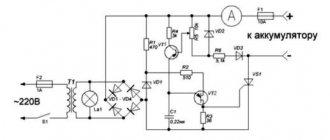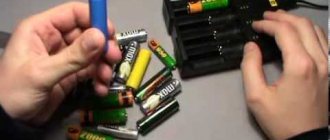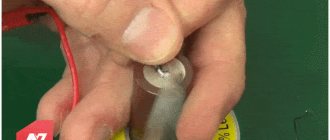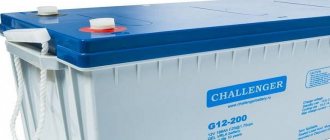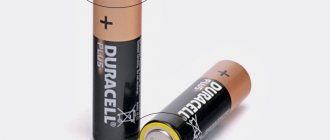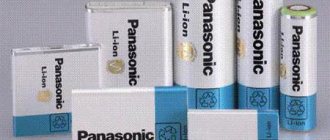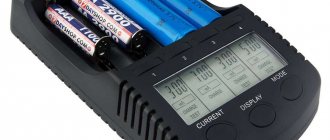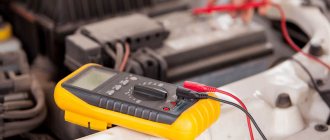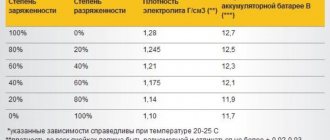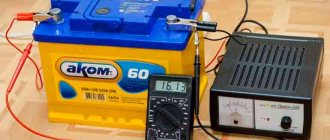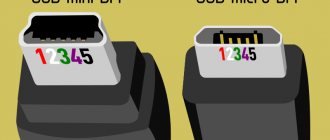It is difficult to find an area where there are no devices running on electrical energy. Mobile sources include rechargeable batteries and disposable batteries that power the consumer by converting chemical energy into electrical energy. Lithium-ion batteries are electron pairs with active components containing lithium salts. The shape of the battery resembles a disposable AA battery, but is slightly larger, has hundreds of charging cycles, and belongs to Li-ion 18650 batteries.
Li-ion battery 18650 device
The production of lithium-ion batteries is based on the sites of Sanyo, Sony, Panasonic, LG Chem, Samsung SDI, Skme, Moli, BAK, Lishen, ATL, HYB . Other companies buy elements, repackage them, passing them off as their own products. They also write false information about the product on the shrink film. There are currently no 18650 Li-ion batteries with a capacity higher than 3600 mAh.
The main difference between rechargeable batteries and batteries is the possibility of repeated recharging. All batteries are designed for a voltage of 1.5 V, the product has a li-ion output of 3.7 V. Form factor 18650 means a lithium battery 65 mm long, 18 mm in diameter.
18650 lithium battery operating mode characteristics:
- The maximum voltage is 4.2 V, and even minor overcharging significantly reduces the service life.
- The minimum voltage is 2.75 V. When reaching 2.5 V, special conditions for capacity restoration are required. When the voltage at the terminals is 2.0 V, the charge is not restored.
- The minimum operating temperature is -20 0 C. Charging at sub-zero temperatures is not possible.
- Maximum temperature +60 0 C. At higher temperatures, an explosion or fire can be expected.
- Capacity is measured in Amps/Hours. A fully charged 1Ah battery can supply 1A of current for an hour, 2A for 30 minutes, or 15A for 4 minutes.
Charging characteristics
For charging lithium-ion batteries, two parameters are important:
- Charging current. In the battery, the charging current begins chemical reactions. The reactions vary from the amount of mass involved on the plates and its thickness, the surface of the electrodes, the thermal range, the unplanned process of electrolysis of water. A weak current does not activate the entire volume of electrode coating, but only its most superficial layer.
- Voltage. The voltage at the current terminals will not be higher than 12.5-12.6 Volts. Only specialists can fully charge such batteries. The operating voltages of a modern battery, below which it is not recommended to discharge 10.8 V and above which it is definitely impossible to raise when charging 14.4 V.
Charge controller for li-ion battery 18650
Major manufacturers produce standard 18650 lithium batteries without a protective board. This controller, made in the form of an electronic circuit, is installed on top of the case, lengthening it somewhat. The board is located in front of the negative terminal and protects the battery from short circuits, overcharging, and overdischarging. Defense is being assembled in China. There are devices of good quality, but there are outright scams - unreliable information, capacity 9,000A/h. After installing the protection, the case is placed in shrink film with inscriptions. Due to the additional design, the case becomes longer and thicker, and may not fit into the intended slot. Its standard size can be 18700, and can be increased due to additional actions. If the 18650 battery is used to create a 12V battery that has a common charge controller, breakers on the individual Li-ion cells are not needed.
The purpose of protection is to ensure the operation of the energy source within the specified parameters. When charging with a simple charger, the protection will not allow overcharging and will turn off the power in time if the 18650 lithium battery runs down to a voltage of 2.7 V.
18650 battery with protection, what is it
To ensure greater safety, manufacturers began to integrate a special electronic board into the battery case, designed to protect against overheating and rupture of the shell. The charge voltage is regulated, and the discharge of the element is also controlled. Whether you purchased an 18650 battery with or without protection, let’s look at how to determine this.
Battery with protection is slightly larger than usual
How to determine whether it is protected or not
It is not difficult to determine the presence of protection in a 18650 lithium battery; as a rule, the manufacturer indicates this on the body of the element itself. Also, when compared with a conventional Li-ion battery, a slight increase in the case is detected, usually no more than 2 mm.
Reference! On batteries with protection you can see the inscription - protected, with protected PCB or protection circuit; unprotected batteries can be produced without additional comments or marked unprotected.
Do you need battery protection?
The voltage applied to the battery when charging it significantly affects the life of the element. The protection blocks charging if the voltage is exceeded or decreased excessively while the battery is being recharged. This ensures longer battery life and safer use.
Marking of lithium batteries 18650
There are markings on the surface of the battery case. Here you can find complete information about the technical properties. In addition to the manufacturing date, expiration date and manufacturer's brand, the device of 18650 lithium batteries and the consumer qualities associated with this aspect are encrypted.
- ICR – lithium-cobalt cathode. The battery has a high capacity, but is designed for low current consumption. Used in laptops, video cameras and similar long-lasting equipment with low energy consumption.
- IMR – lithium manganese cathode. It has the ability to produce high currents and can withstand discharge up to 2.5 a/h.
- INR – nickelate cathode. Provides high currents, withstands discharge up to 2.5 V.
- NCR is a specific marking of Panasonic. The properties of the battery are identical to the IMR. Nickelates, cobalt salts, and aluminum oxide are used.
Positions 2,3,4 are called “high-current”, they are used for flashlights, binoculars, and cameras.
Lithium ferrophosphate batteries have the ability to operate at deep minus temperatures and are restored during deep discharge. Undervalued on the market.
By the marking you can determine whether this is a rechargeable lithium battery with the letters I R. If there are letters C/M/F, the cathode material is known. The capacity indicated will be mA/h. The release date and expiration date are located in different places.
You should know that manufacturers of rechargeable lithium batteries do not have products with a capacity of more than 3,600 mAh. In order to repair a laptop battery or assemble a new one, you need to purchase batteries without protection. To use a single copy, you need to buy elements with protection.
How to test a 18650 lithium battery
If, when buying an expensive device, you doubt the veracity of the information on the case, there are ways to check. In addition to special meters, you can use improvised means.
- You have a charger, you can time the time of full charging with a certain current strength. The product of time and current will reveal the approximate capacity of the li-ion battery.
- A smart charger will help you. It will show both voltage and capacity, but the device is expensive.
- Connect the flashlight, measure the current, and wait for the light to go out. The product of time and current gives the current capacity in A/h.
You can determine the power of a battery by weight: a 18650 lithium battery with a capacity of 2000 mAh should weigh 40 g. The higher the capacity, the greater the weight. But the defectors have learned to add sand to the body to make it heavier.
Charger for 18650 lithium batteries
Lithium batteries are demanding on terminal voltage parameters. The maximum voltage is 4.2 V, the minimum is 2.7 V. Therefore, the charger works as a voltage stabilizer, creating 5 V at the output.
The determining indicators are the charging current and the number of elements in the battery, which you set yourself. Each element (jar) must receive a full charge. Power is distributed using a balancer circuit for 18650 lithium batteries. The balancer can be built-in or manually controlled. Good memory is expensive. Anyone who understands electrical circuits and knows how to solder can make a charger for li-ion with their own hands.
The proposed do-it-yourself charger circuit for 18650 lithium batteries is simple and will turn off the consumer after charging on its own. The cost of components is about 4 dollars, not a shortage. The device is reliable, will not overheat and will not catch fire.
Charger circuit for lithium 18650 batteries
In a homemade charger, the current in the circuit is regulated by resistor R4. The resistance is selected so that the initial current depends on the capacity of the 18650 lithium battery. What current should be used to charge a li-ion battery if its capacity is 2,000 mAh? 0.5 - 1.0 C will be 1-2 amperes. This is the charging current.
Cons of a lithium-ion battery
As with any technology, the lithium-ion battery has significant disadvantages. Weigh them against the benefits to accurately understand the application limitations.
Attention! The exclusive feature of Li-Ion batteries lies in the ability to overcome the shortcomings of the technology due to:
- - tweaks and improvements,
- - changes in the type of chemistry,
- - improving the design,
- — controller and protection settings.
Security - protection required
The main disadvantage of the lithium-ion battery is its unreliability compared to other battery technologies.
To reduce risks and ensure safety, manufacturers have developed protection options against:
- • excessive charge,
- • too strong a discharge,
- • short circuit,
- • unsafe current limits and so on.
a complete list of dangerous manifestations from which lithium-ion batteries require protection separately.
Modern integrated circuits make it relatively easy to integrate a control system—a controller—into a battery or into equipment (when the battery is not interchangeable). It makes lithium-ion batteries safe and allows the cells to be used without any special knowledge.
For example, you can leave your smartphone on charge overnight or even for the whole weekend - nothing bad will happen, since the charger will turn off the power in time.
A protection circuit built into the lithium-ion battery monitors a number of aspects of its operation:
- - limits the peak voltage of each cell during charging, since excessive voltage can damage them;
- - in multi-cell batteries, the cells are charged sequentially through a single power connector so that no cell experiences a voltage higher than required (different cells may require different levels of charge and there is a possibility that someone will overcharge);
- — the cell voltage drop is prevented from dropping too low during discharge (deep discharge);
- — the situation is suppressed when one cell stores less charge than others in the battery (say, in a screwdriver);
- — another aspect of the protection circuit is temperature (the cell can become supercooled or overheated).
The maximum charge and discharge current for most batteries is limited by a temperature increase of 1-2°C. However, some of them get a little warm when charging quickly.
Limited service life - 500-1000 cycles
Wear and tear is one of the most annoying problems with lithium-ion batteries. The number of charge and discharge cycles is limited to 500-1000 cycles, after which the capacity decreases and degradation increases.
Find out what determines the number of cycles until critical wear occurs.
The capacity will drop in any case. With intensive use earlier. If you're careful - later. With the development of lithium-ion technology, this figure is increasing, but sooner or later a replacement will be inevitable. And this can be a problem if the battery is built into the equipment.
Aging - even if not used
In addition to wear and tear from use, the battery is subject to aging even when not in use. The reason is the redox reactions occurring inside it without stopping.
If you plan to store the battery without use for a long time, you should partially charge it. Various documentation indicates a charge range between 40% and 50% . Optimally a dry, dark place with a temperature no higher than +22°C and no lower than +5°C . Storing under these conditions will help extend the service life.
Transportation is difficult
In recent years, many airlines have limited the number of lithium-ion batteries they accept. Their transportation is limited by law. Even we at Neovolt have suffered due to logistics problems of large carriers.
Airplane passengers must carry lithium-ion batteries in their carry-on baggage according to most airline regulations. Conditions change from time to time. But the number of batteries you are allowed to take with you is always limited.
Any lithium-ion batteries carried separately must be of a certain capacity, removed from the device if possible, protected from short circuits by protective caps, and so on. For example, large Li-Ion batteries (as in a UPS) cannot be transported by air at all. Before flying, check whether you can carry a large power bank with you.
Sometimes the requirements are vague, and in fact you have a choice:
- • fly by plane and throw away the battery at the airport,
- • or cancel the flight and choose another transport.
Cost - high
The production cost of a lithium-ion battery is approximately 40% higher than that of nickel-cadmium cells. When developing mass consumer products, any additional costs are a major concern.
Completeness of technology - immature
Li-Ion has been on the market for many years and is still an immature technology. It belongs to the developing field of investment and development. On the one hand, this is a drawback.
We receive an unfinished product , which for many years no one has been able to improve and bring to significant progress.
On the other hand, new lithium-ion technologies are being developed constantly. Could this be an advantage? If more advanced solutions appear, then maybe, but for now we can count them on one hand.
What current to charge a li-ion battery 18650
There is a procedure for restoring the functionality of a 18650 lithium battery after the voltage drops to working voltage. We restore capacity measured in amp hours. Therefore, first we connect the Li-ion battery form factor 18650 to the charger, then we set the charging current with our own hands. The voltage changes over time, the initial value is 0.5 V. As a stabilizer, the charger is designed for 5 V. To maintain performance, parameters of 40-80% of the capacity are considered favorable.
The charging scheme for a li-ion 18650 battery involves 2 stages. First, you need to raise the voltage at the poles to 4.2 V, then stabilize the capacitance by gradually reducing the current. The charge is considered complete if the current drops to 5-7 mA when the power is turned off. The entire charging cycle should not exceed 3 hours.
The simplest single-slot Chinese charger for li-ion 18650 batteries is designed for a charging current of 1 A. But you will have to monitor the process yourself, switch it yourself. Universal chargers are expensive, but they have a display and carry out the process independently.
How to properly charge a Li-ion 18650 battery in a laptop? Connecting a set of energy sources in the gadget via Pover Bank. The battery can be charged from the mains, but it is important to turn off the power as soon as the unit has reached capacity.
How to properly charge the lithium-ion battery of your phone, laptop and other devices How to extend battery life?Preface.
The question of how to properly charge lithium-ion batteries (and, accordingly, phones, tablets, cameras and other mobile devices) has become extremely relevant these days.
This is understandable: the operating time of the device on a single charge, and, often, the lifespan of the entire device as a whole (if the battery is non-removable) depends on this.
And, although the overall control of the charging process is carried out by controllers built into either the “charging” or the device being charged, something also depends on the user. By properly charging (and using) the battery, the user can significantly extend the time of his healthy and happy life.
First, a short scientific excursion into what the nominal voltage of lithium-ion batteries is, and how the percentage of their charge is measured in mobile devices.
Chapter 1. Theory of the issue. Charge and discharge limits of lithium-ion (Li-ion) batteries. What and how do the charge indicators show?
A standard single lithium-ion (or lithium-polymer, Li-pol) battery (cell) has a nominal voltage of about 3.7 Volts with a range of 3.6 - 3.8 Volts.
This voltage rating approximately corresponds to a 50% charge. A freshly charged battery usually has a voltage of about 4.2 V; and a battery with a voltage of 3.0 - 3.2 V is taken as completely discharged.
In fact, the battery can be discharged below 3 Volts, but this is already dangerous for its life and health.
The same applies to charging: you can also charge above 4.2 Volts, but this is also dangerous; and not only for the battery, but also for the people around you.
In the most typical case, the operating voltage range of a lithium-ion battery during operation is from 3.2 to 4.2 Volts (a lower value of less than 3 V is rarely used).
In devices with lithium-ion batteries, when indicating the charge level, the lower voltage threshold is taken as zero (i.e. 3.2 V, not zero Volt); and the upper threshold (4.2 V) is taken as 100%; intermediate values are linearly approximated.
Smartphones show the battery charge level in the form of a bar, often accompanied by charge percentage numbers.
Many smartphones also draw graphs of the discharge and subsequent charge of the battery. The “correct” graph under a uniform test load looks like this (taken from the Asus Zenfone 3 Zoom review):
Everything is correct and beautiful here: a linear decrease in charge and a subsequent linear increase with a slight slowdown towards the end of the process (the levels of 4.2 V and 3.2 V are indicated by the author of the article).
In some smartphones the approximation is not so accurate, then you get concave or convex curves (example taken from the BQ-6001L Jumbo review):
For such smartphones, the user must take into account that towards the end of the charge the percentages drop faster, and the phone may turn off earlier than the user thinks.
There are also completely “crooked” cases when the consumption curve can drop at the end almost instantly by 20 percent (Zopo Hero 1 smartphone):
Here the user must immediately subtract this 20% from the charge indicator readings, so as not to be unexpectedly left without communication. By the way, the charge curve also has a similar jump, but upward (at the end of the charge).
The harm of overcharging lithium-ion batteries is clearly shown in the following graph (taken from this article):
Here you can clearly see that when charging above 4.2 Volts, the number of possible charge/discharge cycles drops sharply.
For multi-cell batteries with a series connection of cells, all of the above is also valid, but with the voltage multiplied by the number of cells connected in series.
Chapter 2. Harmful factors affecting the service life of lithium-ion batteries and ways to deal with them
The most important thing for extending the life of batteries is not to do what they “don’t like.” And they don’t like five things: overheating
,
hypothermia
,
overcharge
,
overdischarge
and
exceeding the permissible charge/discharge current
.
First, let's deal with the most “simple” cases.
1.
The simplest case is
overdischarge
, since it is extremely difficult to encounter this case in life.
Power controllers built into mobile devices very clearly prevent overdischarge. As a rule, when the voltage drops below 3.0 - 3.2 V per battery cell, they simply turn off the mobile device.
But, of course, it is better for the user not to bring the mobile device to this state, and to recharge it in time. This will also help the “longevity” of the battery!
2.
The next situation that is difficult to face in life is
overcharging
. Here, too, the battery controller is triggered, preventing the voltage on the battery from rising above the permissible limit.
But there are also unpleasant exceptions in this regard. They usually occur in cases where, according to the design of the product, the battery needs to be disconnected from the device with which it works for charging and connected “stand-alone” to the charger.
This charging method means that the battery controller is located in the charger, and they, in turn, sometimes have a “defective” design with an overestimated output voltage.
In this case, it is highly advisable to check the voltage at the “charging” output at idle. If it exceeds 4.3 V, then using such charging will be harmful to the battery.
As for the general question of to what level is it better to charge the battery, it is better to undercharge it a little, stopping at the level of 90-95% (although this factor is not particularly critical). In some brands of phones (for example, Sony), during the charging process, the indicator LED switches from red to green not at 100%, but at 90%. After switching the color to green, such phones can be disconnected from charging without waiting for the charge level to reach 100%.
The remaining “harmful” situations are more “real” and can actually occur.
3. Hypothermia
- a common situation, but, fortunately, it does not damage the battery “forever”.
The most critical is to cool the battery below zero degrees (Celsius).
In this case, both the voltage on the battery and its capacity drop simultaneously. Many devices turn off automatically.
But these troubles are not forever. After warming up the battery to normal temperature, all its properties are restored; and even the charge that had disappeared somewhere returns.
There are natural ways to avoid hypothermia. Keep small devices (phones, etc.) in pockets “closer to the body”; large-sized (laptops, etc.) - wrap in heat-insulating material during transportation.
4.
A more serious and dangerous problem is
overheating
.
Overheating can occur both due to high ambient temperatures and due to heating of the device itself during operation; or both at the same time. In addition, the battery heats up during the charging process.
Heating the battery above 40 degrees is not desirable, and above 60 degrees is dangerous. And, in any case, such heating shortens the life of the battery; regardless of whether the battery is working for the load, or just “lying”.
There are many obvious ways and “subtleties” in saving a battery from overheating.
A short list of ways to reduce heat:
— do not place the device (for example, a telephone) in a place illuminated by direct sunlight;
- do not place near heating devices, or on any warm objects (for example, on a computer);
- do not place in places with difficult ventilation;
- do not charge with high current (“the subtleties” of this issue will be discussed a little further).
In addition, when there is a high computing load (for example, in games), it is prudent to remove the phone from the case (cover), since the case makes it difficult to dissipate heat.
For high-performance laptops under intense load, it makes sense to use cooling pads.
5.
Let's move on to the analysis of the next “harmful” point -
charging the battery with too high a current
.
Although, as mentioned above, the charging process is controlled by the appropriate controller, the user also has the opportunity to influence the course of this process.
Reducing the charge current will simultaneously reduce the heating of the battery and will act more evenly on different areas of the battery's working fluid.
The very possibility of exceeding the permissible current often arises due to the simplified operation of the controller, which is not very precisely tuned to the battery used. The variation in the output voltage of the charger can also have some significance (usually +/- 5%).
The length and thickness of the wires of the connecting cable between the charger and the battery can be very important. And the better the cable, the better it is not always.
There are essentially two ways to reduce the charge current: using a longer or thinner cable; as well as the use of a conventional charger instead of a “fast charging” charger.
Some articles recommend using a charger with a lower output current for the same purpose. This, dear readers, is nonsense.
! The fact is that the output voltage and current indicated on chargers have different meanings.
The nominal voltage is indicated
meaning;
and for current - the maximum permissible
value. By using a charger that is weaker in output current than required by the specifications of the device being charged, the user will violate the permissible current conditions, and nothing good will come of it (the consequences depend on the presence of an overload protection circuit and the quality of its operation).
Let's return to the question of using a longer cable to reduce the charging current.
In the most common case, when the phone charger has a standard 5 Volt USB output, this issue is easily resolved: just purchase a 1-3 meter USB extension cable and additionally connect it between the charger and the phone’s standard charging cable.
It makes sense to use this trick when the phone is being charged in a “leisurely” manner (for example, you can leave it charging overnight).
If the opposite task is to charge the phone as much as possible in a limited time
, then, on the contrary, you need to use the shortest possible cable. For example, you can use a standard cable from a power bank: they are 15-30 cm long.
In cases where you own a phone with “fast charging”, you can extend the life of the battery by refusing to use it in “leisurely” cases. To do this, it is enough to use, instead of a charger with “fast charging,” a regular charger of 5 Volts and for the same maximum current as indicated on the device with “fast charging” (usually 2 Amperes).
You can read more about the dangers of “fast charging” in this short article on the ixbt portal.
Separately and especially, it is necessary to consider the issue of “fashionable” portable batteries (power banks) with a solar battery.
These “fashionable” power banks combine all the ways to shorten the life of batteries.
Firstly, charging in direct sunlight leads to increased heating of the batteries (about 20-40 degrees above ambient temperature).
And secondly, charging from solar cells is often done directly there, bypassing the controller, which can lead to overcharging of the batteries.
In this regard, it is highly undesirable
charge such devices using a solar battery. If you happen to have a power bank with a solar battery, charge it anyway in the “normal” way, i.e. from the network adapter.
And let the possibility of charging from a solar battery remain in case of emergencies during a hike.
And, to conclude this chapter, a couple of recommendations about storing unused (backup) batteries and rarely used ones (power banks, etc.).
Experts do not recommend storing fully charged batteries. It is advisable to leave them in storage with a charge level of 40-60%. And when it comes to using them, charge them to nominal immediately before use.
Well, the absolutely ideal way to store them is in a cool, dry place; for example - in the refrigerator at a temperature from zero to 5 degrees above zero (if space allows).
Addition
from 05/26/2019: there is a strong suspicion that wireless charging can also harm batteries. Details - on iguides.ru.
Addition
from 07/11/2019: a database of battery tests (not only lithium-ion) has appeared on the Internet; located on the website https://telnov.wiki/.
Your Doctor
.
January 20, 2022 Recommend this page to friends and classmates
Other articles in the series “How a smartphone works”:
— What is USB OTG in a smartphone and tablet?
— Navigation (GPS, GLONASS, etc.) in smartphones and tablets. Sources of errors. Testing methods.
— Opening (disassembling) the smartphone camera. Smartphone (mobile phone) camera device
— Shooting with a mobile phone (smartphone) camera. Mobile phone camera settings. Main characteristics, problems and examples of defects in the pictures. How to choose a smartphone with a good camera?
— Photography in HDR (High Dynamic Range) mode on a smartphone. What is it, what is the benefit and when can it be used?
— Opening (disassembling) a lithium-ion battery
As usual, flooding, flaming and off-topic topics are prohibited in the comments. It is also prohibited to violate generally accepted norms and rules of behavior, including posting extremist appeals, insults, slander, obscene language, or promoting or approving illegal actions. Compliance with laws is in your best interests!
Comments on VKontakte:
FaceBook comments:
When copying (reprinting) materials, an active link to the source (SmartPuls.ru website) is required!
Restoring li-ion battery 18650
If the battery refuses to work, it may manifest itself as follows:
- The energy source is quickly discharged.
- The battery is dead and won't charge at all.
Any source can quickly discharge if the capacity is lost. This is precisely why overcharge and deep discharge are dangerous, from which protection is provided. But there is no escape from natural aging, when storage in a warehouse annually reduces the capacity of the cans. There are no methods of regeneration, only replacement.
What to do if the battery does not charge after a deep discharge? How to restore li-ion 18650? After the controller disconnects the battery, it still has a reserve of energy capable of delivering 2.8-2.4 V voltage at the poles. But the charger does not recognize a charge up to 3.0V; anything lower is zero. Is it possible to wake up the battery and start the chemical reaction again? What needs to be done to increase the charge of li-ion 18650 to 3.1 -3.3V? You need to use a way to “push” the battery, give it the necessary charge.
Without going into calculations, use the proposed circuit, mounting it with a 62 Ohm resistor (0.5 W). A 5V power supply is used here.
If the resistor heats up, the lithium battery is zero, which means there is a short circuit or the protection module is faulty.
How to restore a 18650 lithium battery using a universal charger? Set the charge current to 10 mA, and perform precharging as written in the instructions for the device. After raising the voltage to 3.1 V, charge in 2 stages according to the SONY scheme.
Charging cobalt-blended batteries
Classic lithium-ion battery designs are equipped with cathodes whose structure is made up of materials:
- cobalt,
- nickel,
- manganese,
- aluminum.
All of them are usually charged at a voltage of up to 4.20V/I. The permissible deviation is no more than +/- 50 mV/I. But there are also certain types of nickel-based lithium-ion batteries that allow a charge voltage of up to 4.10V/I.
Cobalt-blended lithium-ion batteries are equipped with internal protective circuits, but this rarely prevents the battery from exploding when overcharged.
There are also developments of lithium-ion batteries, where the percentage of lithium has been increased. For them, the charge voltage can reach 4.30V/I and higher. Well, increasing the voltage increases the capacity, but if the voltage goes beyond the specification, it can lead to destruction of the battery structure. Therefore, for the most part, lithium-ion batteries are equipped with protective circuits, the purpose of which is to maintain the established standard.
Full or partial charge
The recommended charge rate for the energy cell of cobalt-blended batteries varies from 0.5C to 1C. It takes 2-3 hours to fully charge. Manufacturers of such batteries recommend charging them at a rate of 0.8C or even less, explaining this as positive conditions for extending the life of the lithium-ion battery.
However, practice shows: most powerful lithium-ion batteries can accept a higher voltage level, provided that it is supplied for a short time. With this option, the charging efficiency is about 99%, and the cell remains cool during the entire charging time. True, some lithium-ion batteries still heat up by 4-5C when they reach a full charge.
This may be due to protection or due to high internal resistance. For such batteries, the charge should be stopped when the temperature rises above 10ºC at a moderate charge rate.
Lithium-ion batteries in the charger are being charged. The indicator shows the batteries are fully charged. Further process threatens to damage the batteries
Full charging of cobalt-blended systems occurs at a threshold voltage. In this case, the current drops by up to 3-5% of the nominal value.
The battery will show a full charge even when it reaches a certain capacity level that remains unchanged for a long time. The reason for this may be increased self-discharge of the battery.
Increasing charge current and charge saturation
It should be noted that increasing the charge current does not speed up the achievement of a full charge state. A lithium-ion battery will reach peak voltage faster, but it will take longer to charge until the capacity is completely saturated. However, charging the battery at high current quickly increases the battery capacity to approximately 70%.
Lithium-ion batteries do not require a full charge, as is the case with lead-acid devices. Moreover, this charging option is undesirable for Li-ion. In fact, it is better to not fully charge the battery, because high voltage “stresses” the battery.
Selecting a lower voltage threshold or completely removing the saturation charge helps extend the life of the lithium-ion battery. True, this approach is accompanied by a decrease in the battery energy release time.
It should be noted here: household chargers, as a rule, operate at maximum power and do not support adjustment of the charging current (voltage). Manufacturers of consumer lithium-ion battery chargers consider long battery life to be less important than the cost of circuit complexity.
Li-ion battery chargers
Some cheap household chargers often work using a simplified method. Charge a lithium-ion battery in one hour or less, without going to saturation charge.
The ready indicator on such devices lights up when the battery reaches the voltage threshold in the first stage. The state of charge is about 85%, which often satisfies many users.
This domestically produced charger is offered to work with different batteries, including lithium-ion batteries. The device has a voltage and current regulation system, which is already good
Professional chargers (expensive) are distinguished by the fact that they set the charging voltage threshold lower, thereby extending the life of the lithium-ion battery.
The table shows the calculated power when charging with such devices at different voltage thresholds, with and without saturation charge:
| Charge voltage, V/per cell | Capacity at high voltage cut-off, % | Charging time, min | Capacity at full saturation, % |
| 3.80 | 60 | 120 | 65 |
| 3.90 | 70 | 135 | 75 |
| 4.00 | 75 | 150 | 80 |
| 4.10 | 80 | 165 | 90 |
| 4.20 | 85 | 180 | 100 |
As soon as the lithium-ion battery begins to charge, there is a rapid increase in voltage. This behavior is comparable to lifting a load with a rubber band when there is a lag effect.
Capacity will eventually be gained when the battery is fully charged. This charge characteristic is typical for all batteries. The higher the charging current, the brighter the rubber band effect. Low temperature or the presence of a cell with high internal resistance only enhances the effect.
The structure of a lithium-ion battery in its simplest form: 1- negative busbar made of copper; 2 — positive tire made of aluminum; 3 - cobalt oxide anode; 4- graphite cathode; 5 - electrolyte
Assessing the state of charge by reading the voltage of a charged battery is impractical. Measuring the open circuit (idle) voltage after the battery has been sitting for several hours is the best evaluation indicator.
As with other batteries, temperature affects idle speed in the same way it affects the active material of a lithium-ion battery. The state of charge of smartphones, laptops and other devices is assessed by counting coulombs.
Lithium-ion battery: saturation threshold
A lithium-ion battery cannot absorb excess charge. Therefore, when the battery is completely saturated, the charging current must be removed immediately. A constant current charge can lead to metallization of lithium elements.
This situation violates the principle of ensuring the safe operation of such batteries. To minimize the formation of defects, you should disconnect the lithium-ion battery as quickly as possible when it reaches peak charge.
This battery will no longer take exactly as much charge as it should. Due to improper charging, it lost its main properties as an energy storage device.
As soon as the charge stops, the voltage of the lithium-ion battery begins to drop. The effect of reducing physical stress appears. For some time, the open circuit voltage will be distributed between unevenly charged cells with a voltage of 3.70 V and 3.90 V.
Here, the process also attracts attention when a lithium-ion battery, which has received a fully saturated charge, begins to charge the neighboring one (if one is included in the circuit), which has not received a saturation charge.
When lithium-ion batteries need to be constantly kept on the charger in order to ensure their readiness, you should rely on chargers that have a short-term compensation charge function.
The flash charger turns on when the open circuit voltage drops to 4.05 V/I and turns off when the voltage reaches 4.20 V/I.
Chargers designed for hot-ready or standby operation often allow the battery voltage to drop to 4.00V/I and will only charge Li-Ion batteries to 4.05V/I rather than reaching the full 4.20V/I level.
This technique reduces physical voltage, which is inherently associated with technical voltage, and helps extend battery life.
Charging cobalt-free batteries
Traditional batteries have a nominal cell voltage of 3.60 volts. However, for devices that do not contain cobalt, the rating is different. Thus, lithium phosphate batteries have a nominal value of 3.20 volts (charging voltage 3.65V). And new lithium titanate batteries (made in Russia) have a nominal cell voltage of 2.40V (charger voltage 2.85).
Lithium phosphate batteries are energy storage devices that do not contain cobalt in their structure. This fact somewhat changes the charging conditions for such batteries.
Traditional chargers are not suitable for such batteries, as they overload the battery with the risk of explosion. Conversely, a charging system for cobalt-free batteries will not provide sufficient charge to a traditional 3.60V lithium-ion battery.
Exceeded charge of lithium-ion battery
The lithium-ion battery operates safely within specified operating voltages. However, battery performance becomes unstable if it is charged above operating limits. Long-term charging of a lithium-ion battery with a voltage above 4.30V, designed for an operating rating of 4.20V, is fraught with lithium metalization of the anode.
The cathode material, in turn, acquires the properties of an oxidizing agent, loses its stability, and releases carbon dioxide. The pressure of the battery cell increases and if charging continues, the internal protection device will operate at a pressure between 1000 kPa and 3180 kPa.
If the pressure rise continues after this, the protective membrane opens at a pressure level of 3.450 kPa. In this state, the lithium-ion battery cell is on the verge of exploding and eventually does just that.
Structure: 1 - top cover; 2 - upper insulator; 3 - steel can; 4 - lower insulator; 5 — anode tab; 6 - cathode; 7 - separator; 8 - anode; 9 — cathode tab; 10 - vent; 11 - PTC; 12 — gasket
Triggering of the protection inside a lithium-ion battery is associated with an increase in the temperature of the internal contents. A fully charged battery has a higher internal temperature than a partially charged one.
Therefore, lithium-ion batteries appear to be safer when charged at a low level. That is why the authorities of some countries require the use of Li-ion batteries in aircraft that are saturated with energy no more than 30% of their full capacity.
The internal battery temperature threshold at full load is:
- 130-150°C (for lithium-cobalt);
- 170-180°C (for nickel-manganese-cobalt);
- 230-250°C (for lithium manganese).
It should be noted: lithium phosphate batteries have better temperature stability than lithium manganese batteries. Lithium-ion batteries are not the only ones that pose a danger in energy overload conditions.
For example, lead-nickel batteries are also prone to melting with subsequent fire if energy saturation is carried out in violation of the passport regime. Therefore, using chargers that are perfectly matched to the battery is of paramount importance for all lithium-ion batteries.
Some conclusions from the analysis
Charging lithium-ion batteries has a simplified procedure compared to nickel systems. The charging circuit is straightforward, with voltage and current limits. This circuit is much simpler than a circuit that analyzes complex voltage signatures that change as the battery is used. The energy saturation process of lithium-ion batteries allows for interruptions; these batteries do not need to be fully saturated, as is the case with lead-acid batteries.
Controller circuit for low-power lithium-ion batteries. A simple solution and a minimum of details. But the circuit does not provide cycle conditions that maintain a long service life
The properties of lithium-ion batteries promise advantages in the operation of renewable energy sources (solar panels and wind turbines). As a rule, a solar panel or wind generator rarely provides a full charge to the battery.
For lithium-ion, the lack of steady-state charging requirements simplifies the charge controller design. A lithium-ion battery does not require a controller to equalize voltage and current, as is required by lead-acid batteries.
All household and most industrial lithium-ion chargers fully charge the battery. However, existing lithium-ion battery charging devices generally do not provide voltage regulation at the end of the cycle.
The absence of this functionality results in a reduction in battery life. Manufacturers of imperfect chargers explain the incident by the complexity of the circuit and the general rise in cost of devices.
Instructions: how to charge lithium-ion batteries
- Turn off the consumer device (disconnect additional load from the charger). A parasitic load reduces the efficiency of the charger.
- Charge the lithium-ion battery only in moderate temperatures. Do not charge the battery at sub-zero temperatures.
- Give priority to partial (incomplete) charge up to 80-85%.
- Stop charging if the battery case heats up to a temperature above 50-60ºС.
- Be sure to charge the lithium-ion battery before storing it.
